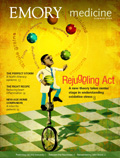Beating back the pandemic devil

As the recent H1N1 (swine flu) virus outbreak proves, speed and collective wisdom are vital in preventing a pandemic.
For instance, scientists with the Emory–University of Georgia Influenza Pathogenesis and Immunology Research Center (IPIRC) are studying how the H1N1 virus enters cells, how it is transmitted, and how to interrupt both processes. They also are working to determine whether prior exposure to other influenza viruses may help or hinder response to the new virus, assess possible pre-existing immunity to H1N1 in different age groups, analyze the recovery of infected patients, and begin new vaccine development.
Emory and University of Chicago researchers are testing a new method of producing highly targeted monoclonal antibodies to develop a diagnostic test and a temporary therapy to stave off the H1N1 virus. The antibodies, which can be isolated from a small amount of human blood infected with the virus, could be targeted against H1N1 and rapidly reproduced to detect or attack the virus.
On yet another front, Emory and CDC scientists are using virus-like particles (VLPs) to develop a faster, more efficient way to make flu vaccine. The current method of growing a vaccine in chicken eggs takes months and would strain the world’s vaccine production capabilities should a pandemic occur. The scientists described the effectiveness of a VLP vaccine in mice in the March issue of PLoS (Public Library of Science) One.
In their study, mice immunized with nose drops containing VLPs were protected for months against an otherwise lethal infection from H5N1, the influenza variant in birds. VLPs appear to deliver several times more potency per milligram in mice than other types of vaccines. “This extra potency is important because the current egg-grown vaccines require relatively high doses to be effective for most people,” says Richard Compans, IPIRC director. “In a pandemic, demand might run up against production capacity. VLPs could offer more bang for the buck.”


